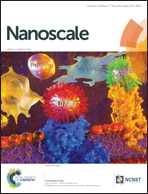Development of a glucose oxidase-based biocatalyst adopting both physical entrapment and crosslinking, and its use in biofuel cells†
Abstract
New enzymatic catalysts prepared using physical entrapment and chemical bonding were used as anodic catalysts to enhance the performance of enzymatic biofuel cells (EBCs). For estimating the physical entrapment effect, the best glucose oxidase (GOx) concentration immobilized on polyethyleneimine (PEI) and carbon nanotube (CNT) (GOx/PEI/CNT) was determined, while for inspecting the chemical bonding effect, terephthalaldehyde (TPA) and glutaraldehyde (GA) crosslinkers were employed. According to the enzyme activity and XPS measurements, when the GOx concentration is 4 mg mL−1, they are most effectively immobilized (via the physical entrapment effect) and TPA-crosslinked GOx/PEI/CNT(TPA/[GOx/PEI/CNT]) forms π conjugated bonds via chemical bonding, inducing the promotion of electron transfer by delocalization of electrons. Due to the optimized GOx concentration and π conjugated bonds, TPA/[GOx/PEI/CNT], including 4 mg mL−1 GOx displays a high electron transfer rate, followed by excellent catalytic activity and EBC performance.


 Please wait while we load your content...
Please wait while we load your content...